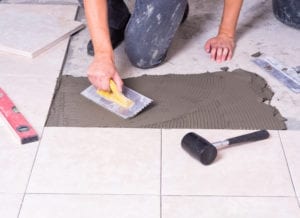
Professional Flooring Installation: 5 Things to Consider
Choosing the right flooring for your home is a pivotal decision that influences its aesthetics, comfort, and overall value. Whether you’re renovating an old space or finalizing the details of a new home, the floor under your feet is as crucial as the roof over your head. Professional flooring installation goes beyond mere aesthetics; it ensures durability, enhances functionality, and can even improve the quality of your indoor environment. However, diving into the world of flooring installation without adequate knowledge can be overwhelming. From selecting the right type of flooring to budgeting accurately, several considerations need your attention.
This blog post dives into five essential aspects you should consider when embarking on a professional flooring installation project. These include choosing the right type of flooring, selecting a skilled professional installer, preparing adequately for the installation process, managing your budget effectively, and understanding the aftercare required to maintain your new floor’s beauty and longevity. By the end of this guide, you’ll be equipped with the knowledge needed to make informed decisions, ensuring a smooth and successful flooring installation that complements your home for years to come.

1. Choosing the Right Type of Flooring
When it comes to selecting the perfect flooring for your home, the choices can seem endless. From classic hardwood to modern vinyl, each type of flooring offers its own unique set of benefits and challenges. Making the right choice depends on a variety of factors including durability, aesthetics, cost, and maintenance. Understanding these factors can help ensure that the flooring you choose not only looks great but also meets the practical needs of your home.
Hardwood Flooring: Timeless Elegance
Hardwood floors have been a popular choice for centuries, offering a timeless elegance that can add significant value to your home. Known for their durability and the warmth they bring to any room, hardwood floors can last generations with proper care. However, they can be susceptible to scratches and moisture damage, making them less ideal for areas prone to dampness or heavy wear, such as bathrooms and basements.
Laminate Flooring: Durability and Affordability
Laminate flooring provides a cost-effective and durable alternative to hardwood floors. With technology advancements, laminate can closely mimic the look of wood, stone, or tile, making it a versatile option for various rooms. It’s highly resistant to scratches, stains, and fading, which makes it suitable for high-traffic areas and homes with pets and children. However, laminate cannot be refinished like hardwood and can be damaged by standing water.
Vinyl Flooring: Versatile and Water-Resistant
Vinyl flooring has surged in popularity due to its extreme versatility and water resistance, making it ideal for kitchens, bathrooms, and basements. Available in sheets, tiles, or planks, vinyl flooring can replicate the look of natural materials at a fraction of the cost. It’s also comfortable underfoot and can withstand heavy traffic, but sharp objects and extreme temperatures can damage it.
Tile Flooring: Durable and Moisture-Resistant
Tile flooring, whether ceramic, porcelain, or stone, offers unmatched durability and moisture resistance, perfect for bathrooms, kitchens, and outdoor spaces. Tiles come in a vast array of colors, patterns, and sizes, allowing for custom designs that can enhance any room’s decor. While durable, tile can be cold and hard underfoot, and grout lines may require regular cleaning to prevent staining.
Matching Flooring Type to Room Usage and Climate
Selecting the right flooring isn’t just about aesthetics; it’s crucial to consider the room’s usage and the local climate. High-moisture areas require water-resistant options like vinyl or tile, while living areas and bedrooms may benefit from the warmth and elegance of hardwood or the comfort of carpet. In regions with high humidity or temperature fluctuations, choosing flooring that can withstand these conditions without warping or cracking is essential.
The decision on which type of flooring to install in your home involves balancing your desires for aesthetics, durability, and practicality. By considering the unique characteristics of each flooring option and how they match your home’s needs, you can make an informed choice that will provide beauty and functionality for years to come.

2. Selecting a Professional Flooring Installer
The successful installation of your chosen flooring depends not just on the quality of the materials, but equally on the skill and reliability of the installer. Selecting the right professional can be the difference between a floor that endures and one that falters prematurely. Here are key considerations to ensure you partner with a professional capable of bringing your flooring vision to life.
- The Significance of Expertise and Experience: Flooring installation is a craft honed over years of experience. A seasoned installer brings a wealth of knowledge about different materials, installation techniques, and how to navigate unexpected challenges that may arise. They can offer valuable advice on the best type of flooring for different areas of your home, considering factors such as traffic, moisture levels, and compatibility with existing flooring. When evaluating potential installers, ask about their experience with your chosen type of flooring and request before-and-after photos of previous projects to gauge their expertise.
- Verifying Credentials and Reviews: Reputation and credibility are paramount. Look for installers who are licensed, insured, and have relevant certifications from recognized industry organizations. These credentials are a testament to their commitment to professionalism and quality. Additionally, explore online reviews and testimonials from previous clients. Platforms like Google, Yelp, and Angie’s List can provide insights into others’ experiences with the installer, highlighting their reliability, communication, and work quality. Don’t hesitate to request references and follow up with them to ask about their satisfaction with the installation process and the final outcome.
- Understanding the Installation Process and Timeline: A professional installer should be transparent about the installation process, from initial assessment to completion. They should provide a clear timeline, including start and finish dates, and explain any preparatory work needed before installation can begin. Understanding the scope of the project helps manage expectations and minimizes disruptions to your daily routine. During consultations, assess the installer’s ability to communicate effectively. They should be willing to answer your questions, address your concerns, and provide detailed explanations of the installation procedures.
- The Importance of a Detailed Quote: Ensure you receive a detailed quote that breaks down the costs of materials, labor, and any additional services, such as removing old flooring or moving furniture. A comprehensive quote can prevent unexpected expenses and provide a basis for comparing different installers. Be wary of quotes significantly lower than others; this could indicate a compromise on materials quality or workmanship.
- Post-Installation Support: Aftercare is an essential aspect of any flooring project. Inquire about the warranty on both the materials and the installation work. A reputable installer will stand behind their work and be available to address any concerns or issues that may arise after the job is completed. Knowing you have support ensures peace of mind and protects your investment.
Choosing the right professional flooring installer is as crucial as selecting the flooring itself. An experienced, reputable installer will not only deliver high-quality work but also enhance the longevity and beauty of your flooring. By carefully considering an installer’s experience, credentials, and approach to client communication and support, you can ensure a smooth and successful flooring installation project.

3. How to Prepare for Flooring Installation
Embarking on a new flooring installation project is an exciting endeavor, but it requires careful preparation to ensure everything goes smoothly. Both homeowners and installers play crucial roles in the preparatory phase. Proper preparation not only facilitates a more efficient installation process but also protects your home and belongings, ensuring a seamless transition to your new flooring.
Steps Homeowners Should Take Before Installation Begins
Clearing the Area: The first step in preparing for new flooring is to clear the area of furniture, decorations, and personal items. Depending on the agreement with your installer, you might need to handle this step yourself or they may offer to assist for an additional fee. Removing items from the space not only makes the job easier for the installers but also reduces the risk of damage to your belongings.
Dealing with Doors and Trim: Flooring installation might affect door opening and closing due to changes in floor height. Remove doors from the installation area and plan for trimming or adjusting them if necessary. Similarly, baseboards and moldings might need to be removed and reinstalled or replaced, depending on the type of flooring being installed.
Addressing Subfloor Issues: A crucial aspect that homeowners often overlook is the condition of the subfloor. The installer should inspect the subfloor to identify any issues that need addressing before the new flooring is laid, such as uneven surfaces, moisture problems, or damage. Addressing these issues beforehand ensures a level base for your new flooring, which is essential for its durability and appearance.

4. The Role of the Installer in Preparation
Site Assessment: A professional flooring installer will conduct a thorough site assessment, evaluating the areas to receive new flooring for any potential challenges. This assessment includes checking the humidity and temperature of the space, which can affect the acclimation of the flooring material, and ensuring the subfloor is in good condition.
Floor Leveling: If the subfloor is not level, the installer will perform necessary leveling procedures. This step is crucial for avoiding future problems such as cracking, creaking, or even buckling of the flooring. The specific method of leveling depends on the type of subfloor and the flooring material being installed.
Acclimation of Flooring Material: Many types of flooring materials, especially wood, need to acclimate to the home’s environment before installation to prevent expansion or contraction post-installation. The installer should guide you on how long the materials need to acclimate, typically a few days, and handle the process if required.
Importance of a Clean Work Environment
Maintaining a clean work environment during installation is beneficial for both the efficiency of the project and the safety of everyone involved. The installer should take measures to minimize dust and debris, using dust barriers and cleaning up at the end of each day. Homeowners can assist by providing access to power outlets, keeping pets and children away from the work area, and addressing any other environmental concerns that could impede the installation process.

5. Budgeting and Costs
Navigating the financial aspects of flooring installation is crucial for homeowners. A well-planned budget ensures that you can achieve your flooring goals without unexpected financial strain. Understanding the various cost factors involved can help you prepare adequately, from material selection to the final touches of installation.
Overview of Potential Costs
Material Costs: The type of flooring you choose is the most significant factor affecting the overall cost. Options like laminate or vinyl offer affordability and durability, whereas hardwood and tile are at the higher end due to their longevity and aesthetic appeal. Prices vary widely based on quality, brand, and features such as water resistance or eco-friendliness.
Labor Costs: Installation costs can differ based on the complexity of the job, the area’s size, and the installer’s experience and reputation. Custom work, such as intricate patterns or the need for significant subfloor preparation, will increase labor costs. It’s important to get detailed quotes from several installers to understand the labor expenses fully.
Additional Expenses: Beyond the basic material and labor costs, consider potential additional expenses. These can include the removal and disposal of old flooring, subfloor repairs, moving furniture, and any necessary adjustments to doors or moldings. Ensure these potential costs are discussed and included in your quotes.
Tips for Budgeting Effectively
Get Multiple Quotes: Collect detailed quotes from several professional installers to compare costs and understand the scope of work each proposes. This step helps ensure you get the best value for your investment.
Plan for Contingencies: It’s wise to allocate an additional 10-15% of your total budget for unexpected expenses. Unforeseen issues like subfloor damage or changes to the project scope can increase costs, and having a contingency fund ensures these don’t derail your project.
Consider Financing Options: If the project exceeds your available budget, consider financing options. Some retailers offer financing plans, or you might explore home equity loans or personal loans. Evaluate the terms carefully to choose the best option for your financial situation.
Avoiding Hidden or Unexpected Costs
To avoid surprises, thoroughly review the installation contract and ensure it includes a detailed breakdown of all costs, the project timeline, and the terms of payment. Ask questions about any unclear charges and confirm that the quote covers the entire scope of work, including preparation, cleanup, and disposal of waste.
A successful flooring installation project begins with a well-planned budget. By understanding the costs involved and effectively managing your finances, you can enjoy your new flooring without financial stress. Preparation, transparency, and a little flexibility can make all the difference in bringing your vision to life within your budget constraints.


Leave a Reply